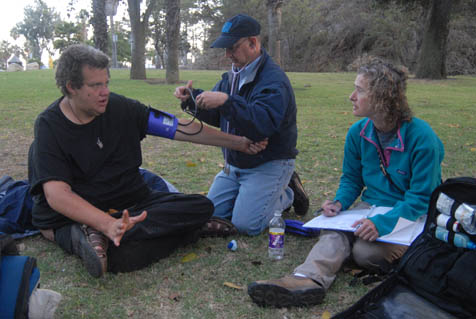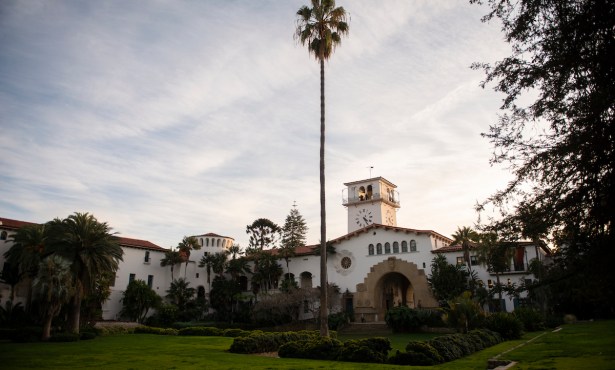A Medical Team Gives Aid to the Homeless
Healing the Forgotten

By the Moreton Bay Fig Tree, across from the flood control tunnels that run under the 101 and a million miles from the Santa Barbara of the Conference and Visitors’ Bureau, a band of volunteer doctors and social workers search for sick homeless people. I followed this Doctors Without Walls (DWW) street medicine team on their Wednesday night rounds a few times this fall, watched them bandage up skin infections and measure the blood pressure of people no one wants to deal with. When it wasn’t sad, it was a peculiarly exciting experience.
DWW’s point of origin is always Pershing Park, where a weekly 5 p.m. potluck put on by the Uffizi Mission Project, a Christian Church founded by Westmont graduate Jeff Shaffer, draws between 20 and 40 of the downtown homeless. Free food is an excellent magnet for the destitute and the Uffizi volunteers are munificent in their offerings: angel hair pasta, baked potatoes with sour cream, salad. The night before Thanksgiving, there was turkey and pumpkin pie.
Mimi Doohan, a family practice physician and DWW founder, pulled together the downtown team this summer after a year of street rounds in Isla Vista. It was a windfall for everyone when lead physician at the Veterans Affairs clinic, Robert Gaines, signed on. A quarter of America’s homeless are now veterans. Jennifer Ferraez and Jason Tarman, social workers with the County Mental Health Department, who, between the two of them, know almost every sheltered or unsheltered homeless person in the South County, are also on the team. So is Project Recovery’s Isabel Blagborne-perpetually on alert for the addict experiencing a moment of openness to change. And finally there is always a strong man to carry the bulging backpack of supplies and watch everyone’s back; sometimes it’s a quiet, young Iraq War vet named John Baker.
Ferraez and Tarman are at the park first. Mingling, they find out who wants to see the doctors about a problem. Most of the time, it’s pretty ordinary ailments; nothing here would ever make it onto House. There was a lice issue in September, almost impossible to eradicate on the street. Six people accepted two rounds of treatments each, and that meant big logistical problems for Ferraez and Tarman. There was a young barefoot woman with a black eye, barely 20, and a large draining abscess on her arm. Gaines slathered antibacterial ointment on it, covered it with bandages, and urged her to go to the emergency room. No one held out much hope she would. In October, a man in the park had chest pain so acute it brought him literally to his knees. It was the only time the doctors have ever called 911. Doohan and Gaines took turns keeping their finger on his pulse until the ambulance arrived. Ultimately it was not a heart attack, but I, for one, thought he was going die right then and there.
After an hour at the park, the team sets out on foot for De la Guerra Plaza, making stops at the Fig Tree or whenever Ferraez or Tarman recognize someone they know who is homeless. There is only one rule: Everyone sticks together. I had no problem with that.
Ferraez and Tarman are breathtakingly fearless. They’ll approach anyone, even in the dark, even if there’s a dog, to ask if medical help is needed. More often than not it isn’t. But street medicine sage Jim Withers says it’s showing up week after week at the same time and location that’s key. Withers, Doohan’s mentor, is an internist. He is pioneering street medicine practice with his seminal Operation Safety Net in Pittsburgh. The theory is, in establishing a consistent, reliable routine and presence, the homeless, so easily spooked by functioning society, will come to trust them and anticipate their appearance.
After three months of rounds, it appears to be working. Take David (aka Dancing Dave) for example. The gregarious, passionate Christian is a regular at the Pershing potluck in his head scarf and leather jacket, almost always in a state of inebriation. (Spirits apparently bring out his spirituality.)
Dave has seen Doohan and Gaines give medical care to friends and acquaintances at the park every Wednesday since Labor Day. But it wasn’t until the last week of November that he sauntered up to Gaines and held out a gnarly, scabbed-over lesion on his finger. Beneath the yellow light of the municipal street lamp, Gaines examined it, asked David to remove his jacket, and saw four others just like it traveling the length of his arm. Gaines palpated his armpits for swollen lymph nodes.
“Obviously, you’ve got a pretty mean infection,” he said. He had David hold out both hands for comparison. The one with the wounds was visibly swollen. Then a medical history was taken; his heart and lungs listened to and blood pressure measured.
Tarman told Dave about a doctor he could see at Casa Esperanza the next day because his infection needed to be cultured.
I asked Dave why it took so long to ask the doctors for help. Those sores didn’t appear yesterday, I said.
“A lot of people think I’m crazy,” said Dave. After a pause, he elaborated. “I think it’s the power of prayer.



